Right at the moment, I seem to be posting about photos and sessions from several days before; in this case, from last Thursday, even though I’ve already done another outing today, um, yesterday – whatever. I’ll let Buggato take the lead on that one, while my own images will show up here eventually.
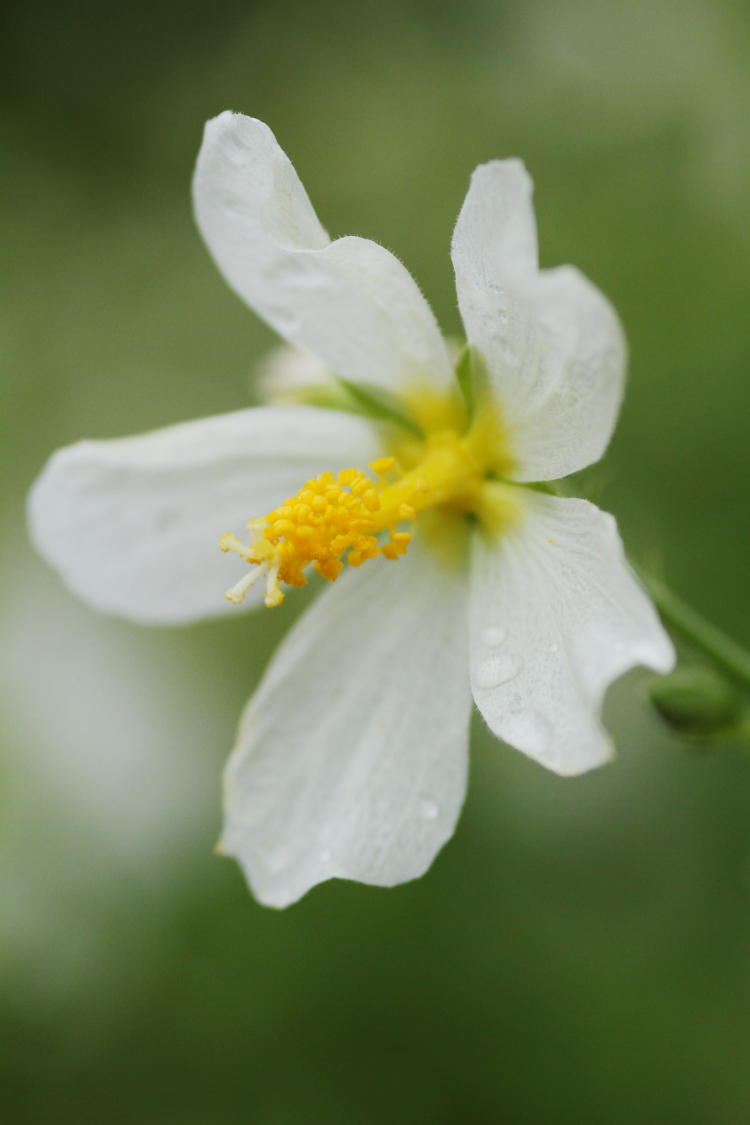
So once the rainy weather had cleared on the 24th, The Girlfriend and I did a quick visit to the NC Botanical Gardens, just to see what was happening. The sky remained mostly overcast, so the light was muted, but it also remained cooler and was pretty comfortable, a big change from nearly the entire summer’s heat. This year seemed to be given over to the reptiles and amphibians within the gardens, well demonstrated by this visit as well. Among the first of the notable subjects was a Carolina anole (Anolis carolinensis) – but it took me a moment to be sure that was what I was seeing.
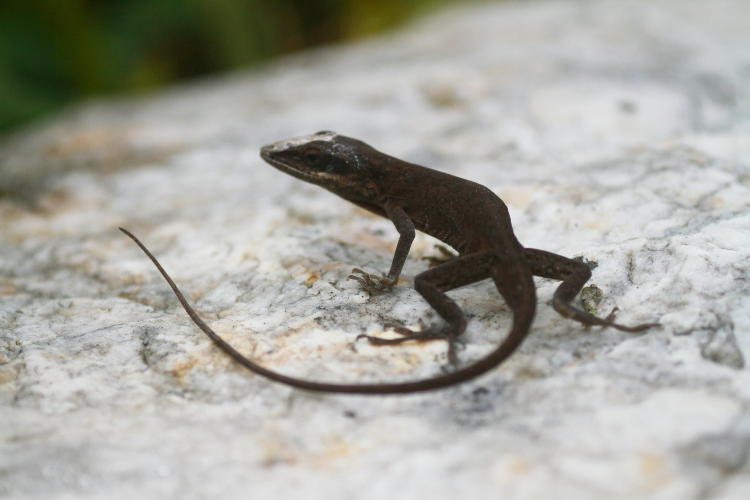
First of, it was the darkest I’d ever seen one, and I knew they could get very deep brown, but this one appeared (perhaps because of the muted light) to be close to solid black. Actually, not quite solid, because it had a large bright path on its forehead, which was also confusing, but as I drew in closer it was revealed to be a patch of molted skin that had not fully detached yet. Having decided to perch on a boulder of quartzite, the palest rock in the region and almost like marble, it wasn’t exactly blending in. I spooked it as I tried to go in closer, but as we were leaving I made another pass through the area and found it again, this time being able to get much closer. It seemed to be brighter now, but again, maybe just from the lighting.
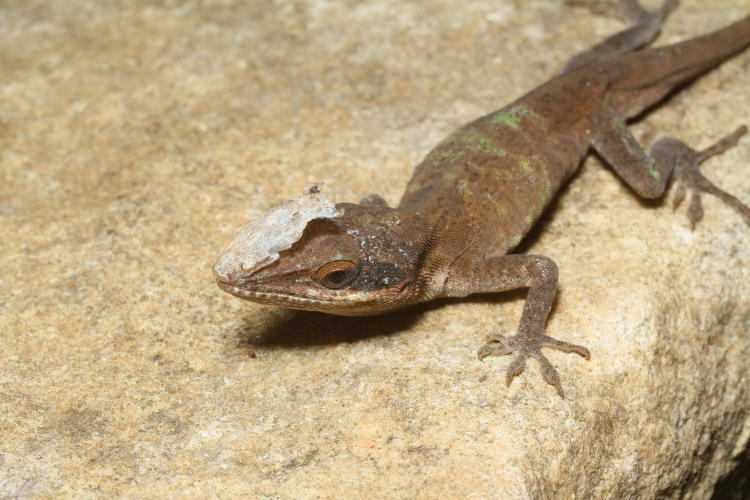
I had affixed the macro flash rig by this time, so I could produce much better results. And you deserve a closer look at this same frame.
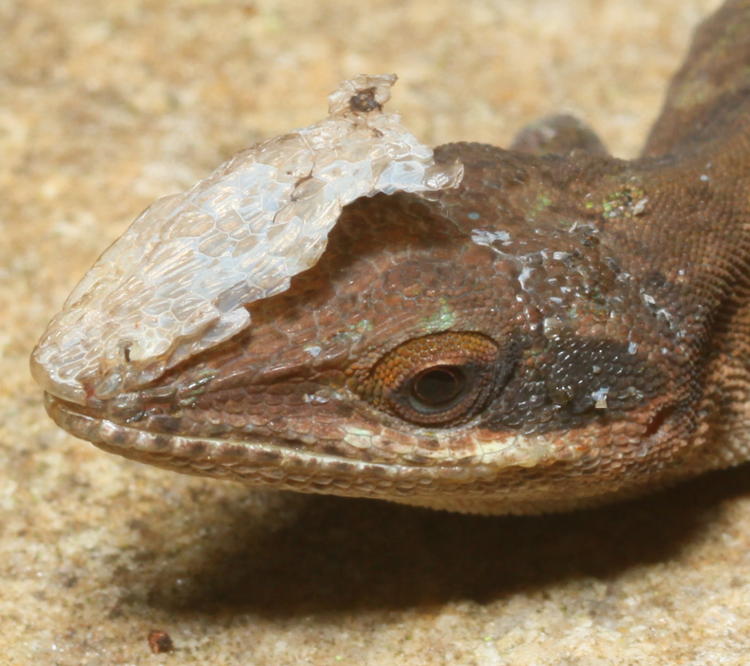
A hard shake of the head, a swipe with a foreleg, or just rubbing it on a handy surface would probably have dislodged that skin, and we’d do it in a heartbeat, but the lizard didn’t seem fazed, perhaps because it wasn’t obstructing vision nor even attached enough to itch. Other small flakes can be seen on the cheeks – anoles don’t shed like snakes, all in one piece, but bits at a time. Now have I mentioned that I love this lens? I mean, within the past five posts?
In multiple locations, we spotted more of the anoles, the typical coloration this time, both adult and very young, less than half adult size (which means they could have perched comfortably on your little finger.) I inadvertently spooked one in plain sight as I reached for a ripening passion fruit, annoying myself, but was still able to capture images as it peered at me from semi-concealment.
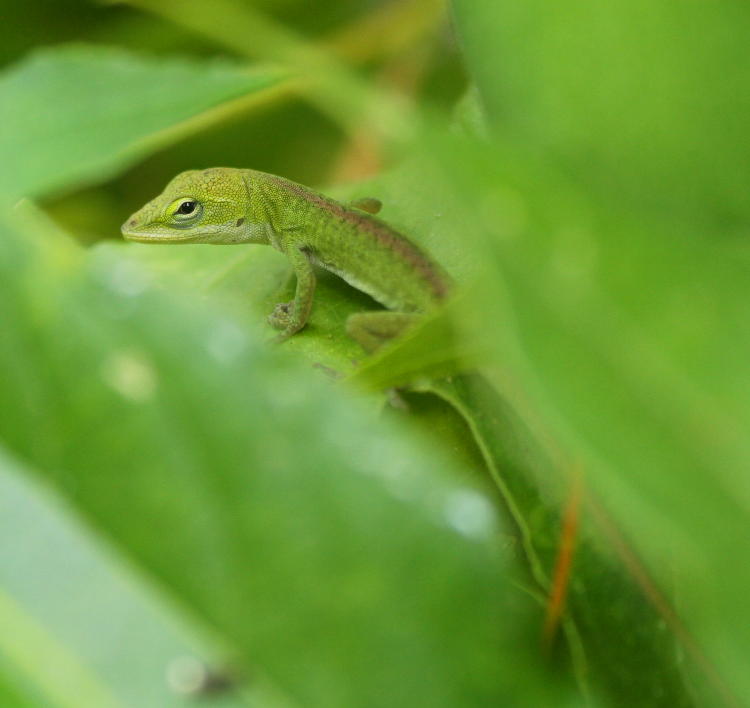
Any expression of irritation or disdain that you’re seeing from the anole is strictly imaginary. Probably. But I still felt chastened.
And then, the frogs.
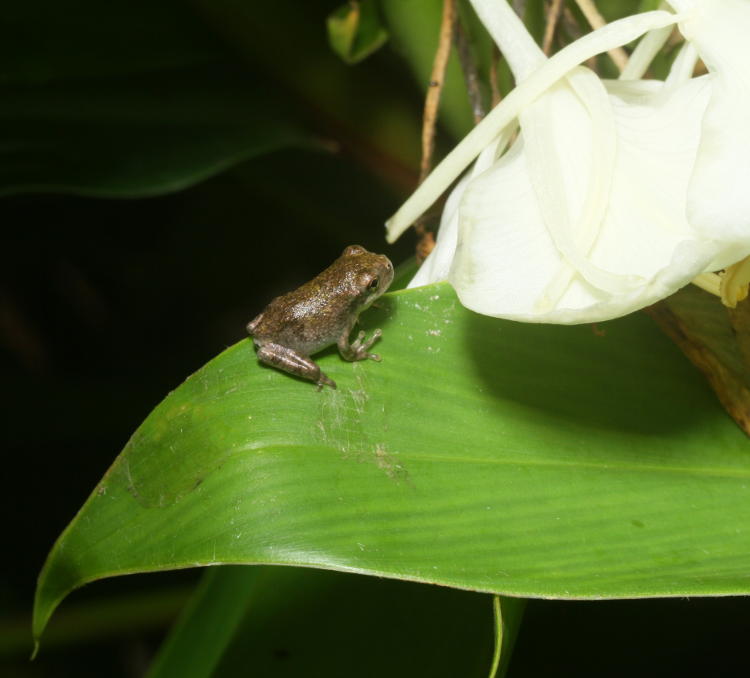
We saw a horde of tiny treefrogs all over the place, if we looked carefully, because they were all about fingernail sized, if not smaller; I’m almost certain they were all, like this, Copes grey treefrogs (Hyla chrysoscelis.) That’s a largish flower bloom in the photo, but not that big, though we have better scale shots to come. Seriously, the frogs were to be found everywhere.
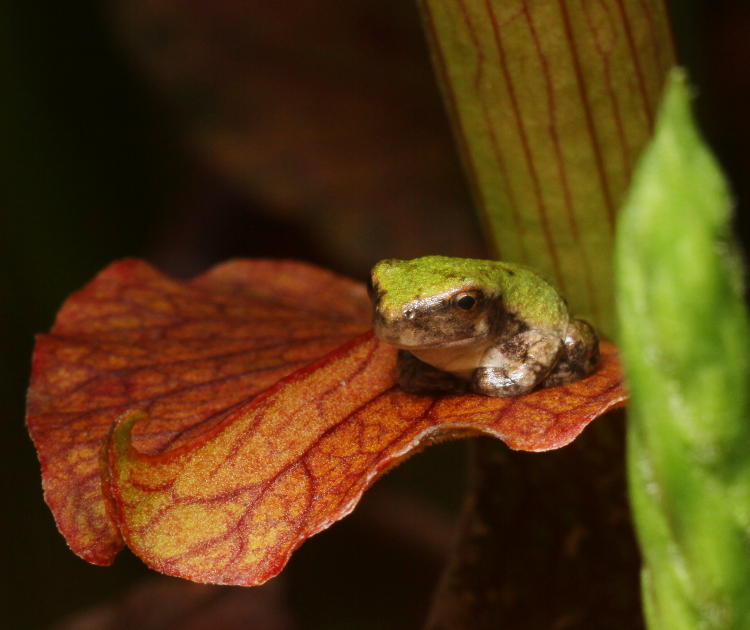
This is one atop a pitcher plant, which required an awkward and taxing position to obtain this portrait angle – seriously, I have a pulled muscle in my side that isn’t recovering because I keep doing things like this, but you know, fame and fortune and other imaginary benefits…
It would be easy to believe these represent different species, but no, the white spot under and behind the eye is a telltale of the grey treefrog, and the Copes subspecies is the only one we seem to have in the area; they’re just capable of color variations, but I don’t know if this is genetic, environmental, or controlled. The green hue is nicer, though.
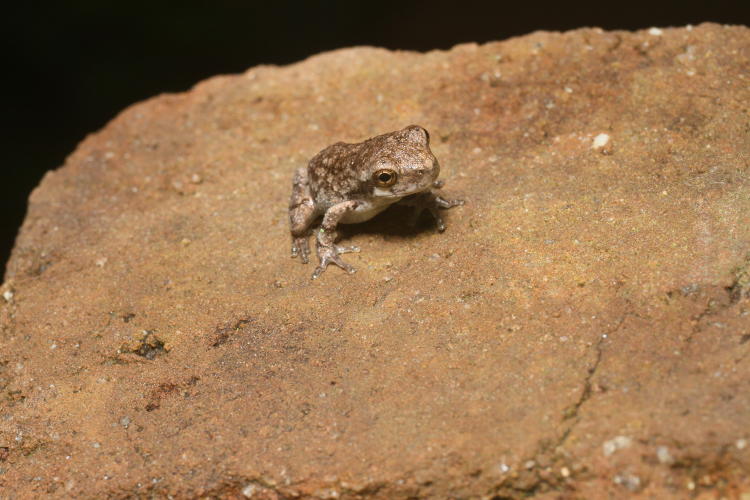
Probably about fifty or more meters away on the other side of a building was where we found this one, so I’m not crediting these to all one hatching, though that’s not impossible, especially with hitchhiking on plants that the gardeners were moving around. But I want you to know that this one is sitting on the end of a typical terracotta building brick, so picture that in your mind as we go closer.

This lens is kickin’, lemme tell you. Though I said that we’d have better scale shots, didn’t I? As this one decided to hop out of such an exposed location, The Girlfriend was able to slip her hand in unnoticed.
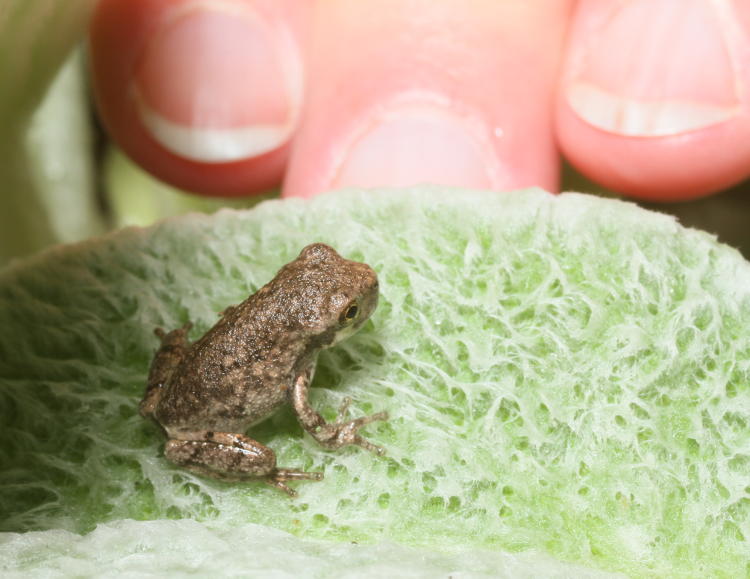
Is that adequate to convey the size? Sometimes it helps a lot to have assistants. Hmm, that could be where the word comes from, now that I think about it…
I was not neglecting the insects on this trip, though they were less numerous, believe it or not.
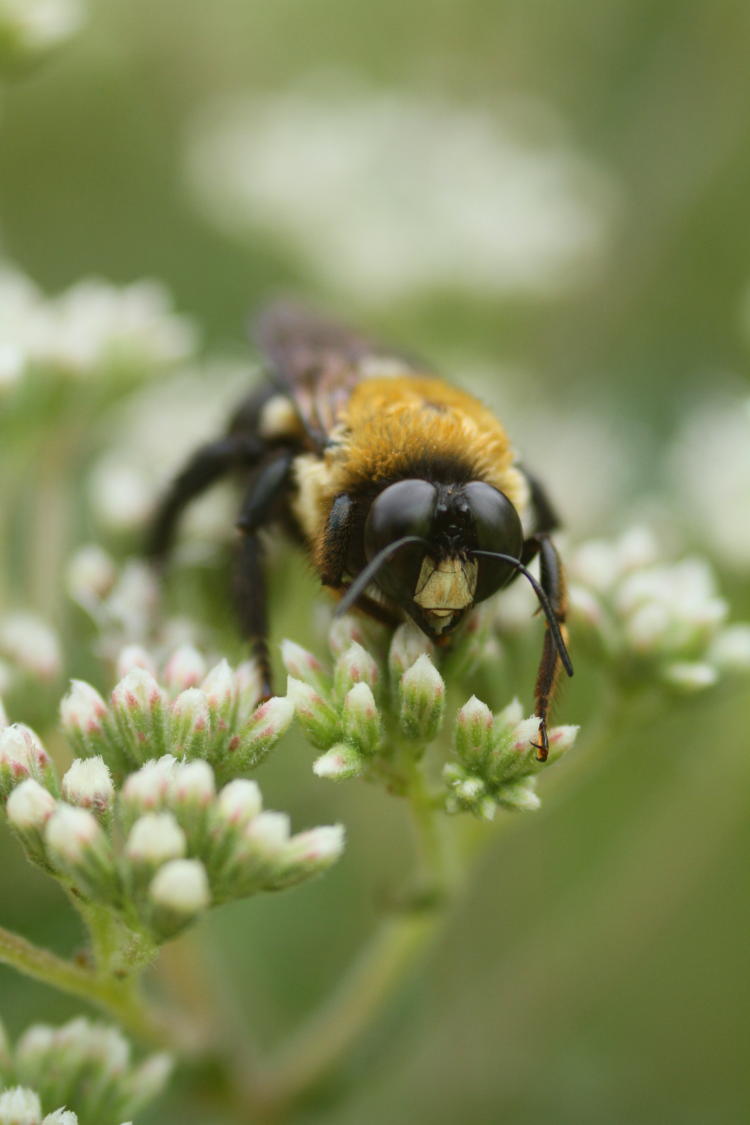
In the previous post, we had a southern carpenter bee snoozing in the pollen; this time it’s an eastern carpenter bee (Xylocopa virginica) that’s fallen asleep on the job, even though it was mid-afternoon at the time. I can relate; it makes perfect sense to grab some sleep in the afternoon, so you can devote late night hours to sitting up and writing overdue posts. Though don’t ask me what a carpenter bee has to write about, since I have a hard enough time determining what I have to write about.
[“Yeah, Al, tell us something we don’t know,” I hear ya, shut up anyway.]
Some distance away but potentially on the same species of flower, since I can’t be assed to look them up this late at night, we had some decidedly unsleepy wasps.
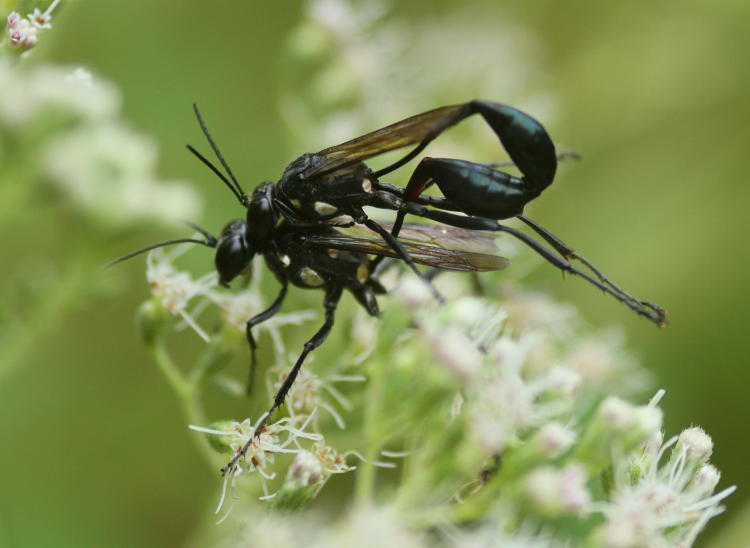
There is apparently only one species of thin-waisted wasp throughout this side of North American at least, and it’s Eremnophila aureonotata, so identifying these was easier than expected. They’re also known for aardvarking on flower clusters so, you know, change it up a little, guys. Also helping the identification was, in the words of BugGuide.net, “silvery patches on the sides of the thorax (pronotal lobes and mesopleura) and next to the propodeal spiracle and petiole socket.” Ah, yes, the old petiole socket, yes indeed…
I continue my quest for mantids either mating or laying eggs, but have been finding few at all, much less engaging in such behavior (flowers clusters or no.) In fact, it took quite a while before I even spotted one in the gardens, peering at me from moderate concealment.
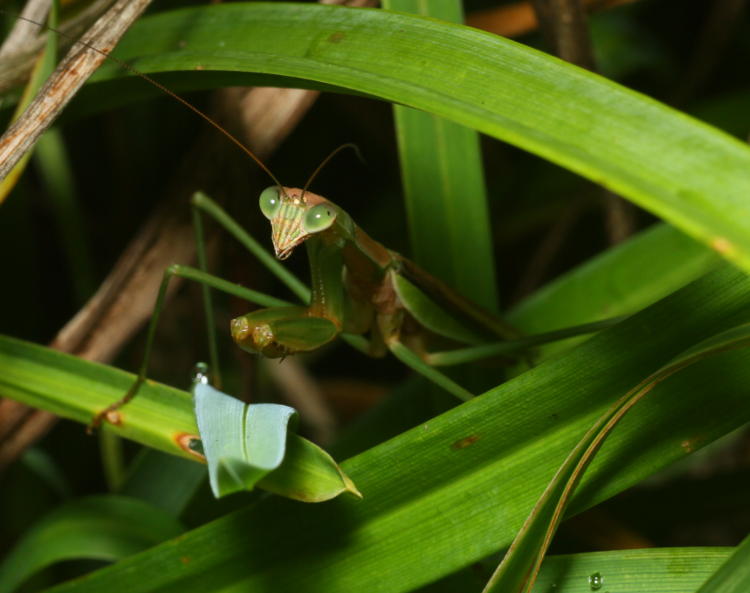
From the size and girth, I’m guessing this was a male, so fairly unlikely, in my professional opinion, to be laying eggs anytime soon. After a while, we found another on a sign – it’s presently an annual event called Sculpture in the Garden, so there are sculptures and descriptive plaques scattered throughout the grounds. This mantis, likely also a male, wasn’t looking all that tip-top, since something had taken away nearly all of its wings and elytra.
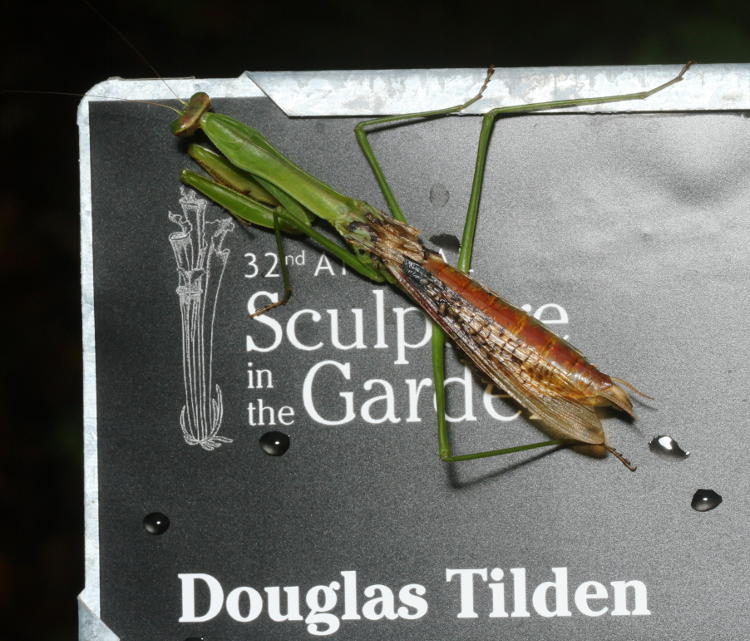
Would this make a difference to a female? Had it already? Do mantids have ‘marital aids’ that could conceal this? The questions abound.
Elsewhere could be found, in a very restricted area, a large number of stink bug nymphs, in varying instar stages but most resembling this one.
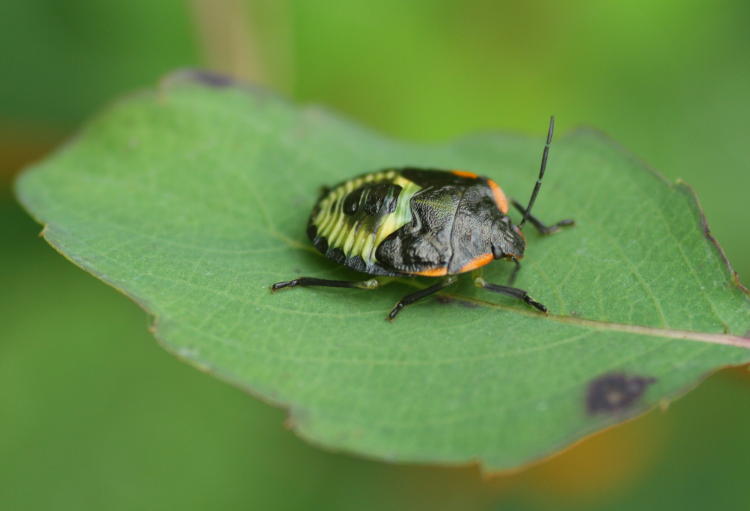
Some posts back, I obtained photos of green stink bugs (Chinavia hilaris) hatching, and it appears this is what they look like as 2nd or 3rd instar nymphs, but I’m not going to bet the farm on it, because I have no idea how many other species might also look like this. And I checked, but I didn’t find any evidence of the egg cluster nearby. I thought I should feature a later stage anyway, this one being about six to eight (certainly not seven) times the length of the newborns, not far from adult size though the wings haven’t developed yet.
We just had a lynx spider, but you can never have too many lynx spiders, I always say, if by ‘always’ you mean, ‘never before in my life have I said that and I’m unlikely to make a habit of it now.’
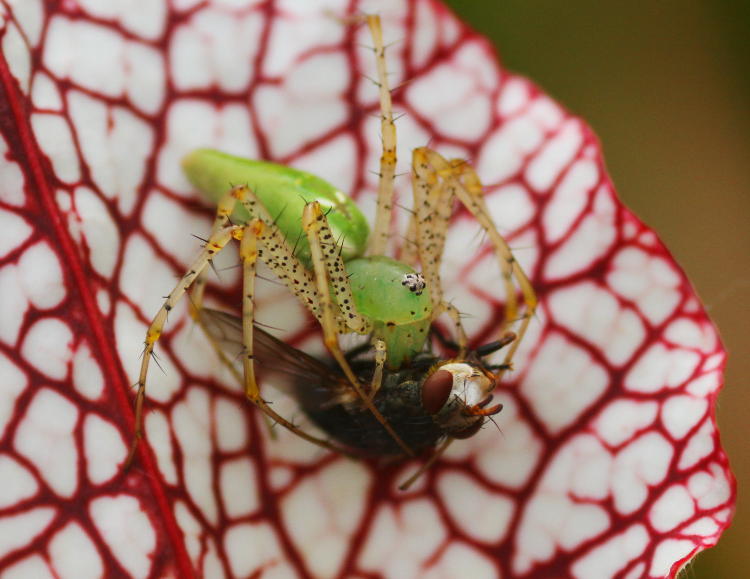
On one species of pitcher plant, a green lynx spider (Peucetia viridans) sat consuming some prey. On a previous visit we’d seen another on the same kind of plants, and in fact, I’ve seen them there quite often, despite the fact that they certainly don’t blend in at all – just goes to show you how stupid flies are I guess. Worse, though, is that the spiders are taking advantage of the pitcher plants’ native appeal to insects and using that for their own purposes, exploiting the pitcher plants to deprive them of food instead of, you know, evolving their own attractive abilities (like, start with losing the spikes, guys.) Thus it remains possible* that the brilliant red-and-white coloration of the pitcher plants is in response to this, drawing the attention of birds to the bright green tasty morsel so they can keep their hard-earned meals to themselves; we’ll know if the plants start developing, say, blinking lights or the appearance of bird seed or something. Nature is weird.
We’ll close with a ripe hearts-a-bustin’ (Euonymus americanus) seed pod seen from below, another awkwardly-obtained shot, but colorful, you gotta admit. I probably should have saved this for the winter months when we’ll need more color, but naaahhh…

* Less than 0.0001% likelihood, honestly



















































